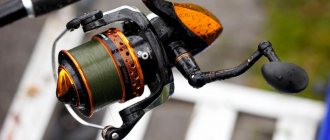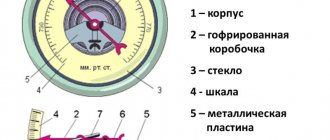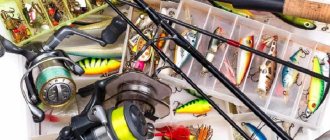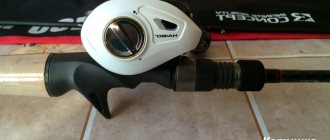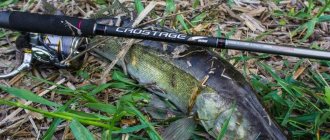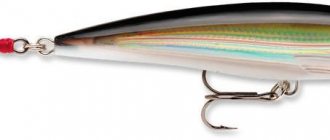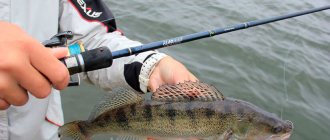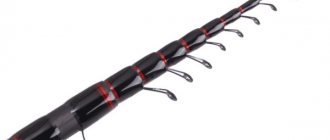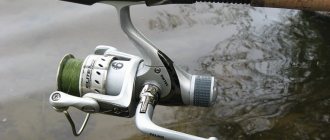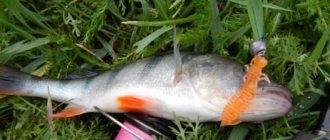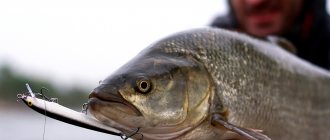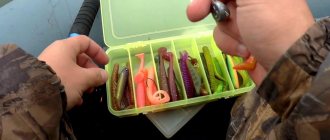What should a spinning rod be like for twitching?
Which spinning rod should I buy for twitching? The use of twitching wiring when fishing with large wobblers places two main requirements on the rod.
Firstly, for twitching with large wobblers, a fast action rod is preferable. It allows you to cast bait far and resist the force of the wind. The hooking is of high quality, which is especially important when fishing for pike and pike perch. It is important here that the upper limit of the spinning test exceeds the weight of the wobblers used. If the fisherman has wobblers with large blades in his arsenal, then he needs to take into account the significant resistance of the bait when retrieving it.
The optimal combination of a rod and a wobbler would be to play only the tip of the spinning rod when twitching the bait.
Secondly, the optimal length of a rod for twitching is considered to be 2-2.4 m. This spinning rod is convenient and easy to work with. But situations often arise when a longer “stick” length of up to 3 m is required. This is necessary when casting a large wobbler long distance, when fishing from a grassy bank. But with such a spinning rod it is more difficult to perform twitching, and the hand gets tired faster.
Standard spinning rod test for twitching: from 5 to 30 grams.
Ultralight spinning rods can also be used as twitching spinning rods in cases where the angler fishes with ultra-light wobblers.
How to choose a spinning rod for 130 and other wobblers?
A good spinning rod is characterized by a pleasant retrieve. A high-quality product will reveal the full potential of the spinning rod and further fishing.
Incorrect behavior of the wobbler can be due to both the inexperience of the fisherman and due to poor spinning. Even in the best hands and with the best wobbler, the bite may not occur.
Material
- High-quality graphite remains the most popular and high-quality material.
- It meets all the requirements in terms of power and weight category, since both the first and second indicators are important for a spinning player.
- High-modulus graphite is extremely durable and comfortable to use.
Build
For jerking retrieves with clear animation of the wobbler, fast or ultra-fast formations are suitable.
The advantages of this choice:
- Possibility to carry out full-fledged animation;
- Control of every movement of the wobbler;
- Doesn't "fail".
Among the disadvantages it is worth noting:
- Difficulties when fishing (compensated by the brake setting of the reel).
Length and weight
When fishing from the shore, it is more convenient to use a long spinning rod (2 meters or more) - it can be cast further and maneuvers are easier to control. From a boat, shorter analogues (1.80-2.00 meters) are preferable. Therefore, choose a spinning rod that is optimal for both types of fishing - about 2-2.10 meters.
By weight: the most equipped ones are quite heavy. When fishing with a wobbler, the emphasis is on the work of the hand, and not on the elbow. After an hour or more, a feeling of discomfort will appear and fishing productivity will decrease.
Let's celebrate! Choose the lightest options with the necessary arsenal (don’t sacrifice functionality, it’s better to take breaks while fishing than to miss a catch).
Spinning rod handle
- The optimal spinning rod handle should be equal to the length of your elbow.
- If it turns out to be longer, it will cause inconvenience, cling to clothes and distract.
- Pay attention to the timing of the stick release.
- Modern versions are equipped with a spaced handle. This greatly reduces the weight load, making the wiring more sensitive.
Test
- The spinning test for a wobbler directly depends on its (wobbler) weight category.
- It is correct to pay attention to the upper test so that there is a gap of a couple of grams, depending on the purpose of further use.
- An indicator of an erroneous choice of the upper test is failure during jerks.
- If you continue to use such a load, the spinning rod may break if you use force.
Passing rings
There is 1 pass ring for every foot of spinning rod length. Thus, for a two-meter version there are 6 rings and always a “tulip”.
The tulip is chosen as carefully as possible, since it is responsible for the largest amount of load.
Note! The rings themselves must be made of a wear-resistant base.
Often there is a problem of insufficiently strong attachment to the base - this leads to rapid failure of the rings.
The best spinning rods for twitching
There are a large number of good spinning rods that allow you to fish by twitching. As an example, we should highlight several proven “sticks” in our rating of spinning rods for twitching.
The company's Norstream Kando KDS-662L rod It is suitable for short-distance fishing on small rivers for fish species such as pike, ide, and chub.
The St.Croix Legend Elite LES70MF2 spinning rod is a legend of twitching fishing. It has a fast action and an ergonomic handle. The length is 2.13 m, and the test is 5-17 g. Allows you to work with wobblers, spinners, jig baits and spoons.
The Restaffine Monster Edition 83H is a unique all-round rod. It makes it possible to perform both twitching and jigging. Optimal for fishing from the shore, it has perfect balance, which does not tire your hand. Provides reliable hooking, long casting and comfortable fishing.
Rating of the best-selling spinning rods and other fishing products on one page! Readers have already joined in shopping from China on Aliexpress. Join us too.
What gear to choose for pike fishing - a detailed overview of the most popular fishing methods and the gear you will need.
Catching catfish with a spinning rod - the secrets of catching giants with spinning tackle: bait, retrieving, finding a fishing spot.
Shimano spinning rods - the best models and review of spinning rods for different spinning methods.
"White" predator
Let's say we catch a white predator - chub, asp, ide - on the riffles of a medium or small river. A decent current, as a rule, and the potential for catching very large specimens impose a number of specific requirements on the rod. As bait we use floating or sinking wobblers: cranks, fats. When rolling, they provide very decent resistance when retrieving, but the size and weight of these lures do not allow you to go beyond the light class of the rod, so as not to lose casting range. At the same time, next to the riffle there are usually lulls, places with weak and reverse currents, where various minnows and shad come into play.
They are deprived of their own active game, therefore, when serving them, you must definitely play along with the rod. So a certain type of spinning rod has developed for these conditions: capable of working with small weights, with good casting, powerful enough to work with stubborn baits in the current and confidently play large and playful fish. It would also be desirable that the rod could be twitched, since there is no wobbler that would not “shoot” once with uneven wiring. In our opinion, the names of wobbler-roll rods are fully deserved by two such different models as the Talon VI Plus 76LF2 with a test for lures of 1/4-3/8 ounces and St.Croix Avid AS76MLF2 with a test of 3.5-14 grams, which we We have the pleasure of fishing for a long time. The test range of these rods is just suitable for various “thick” - chub in our understanding - wobblers. VI Plus perfectly handles fats up to 11 grams, Avid - up to 14.
Although they can throw one and a half times more weight without straining, guiding large and stubborn baits will undoubtedly cause difficulties. The power of both spinning rods allows you not to give much chance to the fish when playing and does not create problems during a strong “estrus”. In addition, “Talon” perfectly works on twitching wobblers. It’s especially nice to fish with such a “stick” on small shad with their own game, such as Cheerful 40F and Alterldem 42SP MR from Pontoon 21 or Masu Master Shad 40 and the like. The ability to feel the moment the bait begins to play allows you to very finely control the wiring. As for Evid, many consider it one of the best sticks for twitching, so there is no need to comment on it.
Read: Catching bream in winter using a combine harvester and making fishing tackle
How to choose a spinning rod for twitching
When choosing a spinning rod for twitching, you should start with the following points:
- It is necessary to conduct a thorough inspection of the rod blank. No chips, scratches or peeling are allowed. Checking the rod in working condition is to determine whether it fits comfortably in the hand of the spinner and how light it is.
- When shaking the spinning rod there should be no crackling or extraneous sounds. The assembled rod must be a single unit.
- Particular attention to the quality of the joints of the knees, it should be long and tight.
- The reel seat must be firmly secured and not rotate on the blank.
- You need to inspect the access rings very carefully. When using braid, the slightest roughness on the inner surface of the ring will cause the line to become tattered in a short time.
Rings with SiC silicon carbide inserts have proven excellent.
Budget rods for twitching
Among the many cheap spinning rods, it is worth highlighting several models that can be used for high-quality jerking.
- The Sabaneev Master Spin 210 rod allows you to “twitch” baits from 5 to 12 g. This double-legged carbon fiber rod can catch medium-sized pike and perch.
- Salmo has an inexpensive spinning rod for twitching. This is a Salmo Elite X-Twitch MH rod with a length of 1.98 m and a test weight of 5-25 g. It has a good range and allows you to perform any kind of wiring from smooth jerks to aggressive twitching.
- The Norstream Standard 762MH spinning rod has a length of 2.29 m and a test of 7-28 g. The rod works equally well with both small wobblers and monsters weighing more than 20 g and 15 cm long.
Spinning rod equipment and selection of baits
The spinning rod for twitching is equipped with a spinning reel, which should lay the line well.
As an example, we can mention Twin Power from Shimano or an analogue from Daiwa. When equipping an inexpensive reel with soft braid, you will have to leave the height to the side of the spool approximately 5 mm, instead of the recommended 2-3. Then the formation of beards and shedding of loops during casting will be minimized. When performing twitching wiring, multifilament fishing lines are used. The requirements for braided line are quite simple, which is due to the sagging of the line after jerking. Power Pro cords or Fireline thermofuse lines are suitable for twitching. It is preferable to use bright colors, which gives additional visual control of the bite and the wiring itself. It is best to use cords marked “Fluo”.
Usually, when jerking, various models of wobblers are used. But sometimes twitching a oscillating spoon or light rubber brings success. The shapes, colors and weight of baits can be different. You just need to take into account the capabilities of the spinning rod and the fishing conditions.
Motor for an inflatable boat - how to choose the right one, features of selecting a motor for a rubber boat.
Spinning rods St. Croix - features of choosing branded spinning rods.
Boat jig
We bought a boat! Now, along with the pleasant opportunity to fish where they couldn’t before, a problem has arisen: what to fish with? In jig fishing, we now have access to deep edges on our native reservoir, and we can also cast along the flooded forest or work pike perch holes with a heavy jig on the Volga or Oka. Doing everything with a long shore stick is not very convenient. But after purchasing the boat, we, alas, did not have the funds to purchase a full set of rods for fishing from a boat on various bodies of water. Therefore, we will have to choose one, but so that it will be for all occasions of our new boat life. And a compromise, as it turned out, is possible!
We settled on two models of the Certified Pro series from Lamiglas that recently appeared in Russia: XS663-2 and XS703-2. First of all, the lightness of these short rods attracts attention: they are perfectly controlled with one hand and this does not tire at all. Both rods have a stated test for lures of 10.5-21 g, but this, it seems to us, is only in the case of very stubborn lures: initially these rods were created in a single-piece version for catching American bass. Be that as it may, they can easily cope with casting baits weighing up to 28-30 g. The inscription on the rod “3 Power” and the declared power of 20 pounds also indicate their very good power indicators. However, all this does not mean that these rods should be unnecessarily overloaded. And we fish from a boat, so a long and powerful cast is not needed.
The heavy jig was dealt with and the topic of the Oka and Volga was closed. But what about the reservoir with snags and shallow navels? After all, here we rarely go beyond a light jig. With the lower test limit for our rods stated by the manufacturer at 10.5 g, visual control of jig wiring along the tip of the rod in good conditions begins at 6-7 grams. And starting from 10 g, the wiring can be felt by hand on more or less hard ground, if the braid is thin enough. The length of these rods - 6.5 and 7 feet - allows two people to fish in a boat without interfering with each other. Re-equipping a spinning rod is also easy: you don’t have to reach far for the tulip, it’s nearby.
Read: Asp fishing before the ban
Note that both rods hold fish very well: option 703 is a little better, 663 is a little worse. It doesn’t rip the perch’s lips, but it kills the pike perch at any depth and distance. The fairly lively tip perfectly detects even the most cautious bite, and the powerful butt does not allow large pike or pike perch to go into snags or get caught on the edge. Tactile sensitivity, we believe, will not raise any doubts, given the glorious history of the Certified Pro series.
Technique of jerk wiring during twitching
When performing twitching, periodic jerks of the rod alternate with pauses of varying durations.
So, fishing in cold water is accompanied by long stops, for 10-15 seconds. Most bites occur during the pause.
The jerk is made with a short wrist movement. A necessary condition for twitching is the obligatory rewinding of the fishing line after each jerk and stop of the rod. When twitching, the tip of the rod is at the surface of the water. The selection of the amplitude of jerks and the duration of the pause are influenced by such factors as the size of the wobbler, the activity of the predator, and weather conditions.
Catching perch with suspended wobblers
Perch also has great respect for suspenders. But, unlike the “toothy” one, a different wiring is preferable for it, which is due to the hunting characteristics of the “striped”. If the pike usually overtakes the prey with a short throw from an ambush, then the perch can pursue the prey for quite a long time, trying to deprive it of maneuver, for which it “displaces” it into the upper layers of the water or towards the shore. The driven fish rushes around in fear, making short throws to the sides, but does not find salvation - the striped hunter rarely misses its prey.
Perch is passionate and persistent when hunting, so the fishing technique here should be somewhat different. The striped robber does not wait for prey in ambush; it travels along a specific route, raiding places where potential prey is expected. At the same time, the perch is not afraid of noise, but, on the contrary, often goes towards it.
Therefore, our first task will be to attract the “striped” one from afar. This means that the suspension must be pulled more energetically, with fairly sharp jerks of the rod (twitching or jerking) so that the bait “sounds” loudly - this will allow the perch to quickly detect it and begin chasing it.
But it is quite difficult to catch up and grab the “jumping fish” and, in order to make the task easier for the “striped fish”, after several energetic jerks we switch to smoother pulls, performed with a reel. At the same time, the bait moves in small jerks, just like a fleeing fry - how can a perch miss its prey? The predator persistently pursues it - and as soon as the prey weakens and slows down, it will be immediately captured. Therefore, short jerks with the reel smoothly turn into a slowing movement of the handle: the exhausted “fry” swims a few more centimeters and stops - the best moment to attack!
However, at the moment of stopping, one of the main disadvantages of all jerk baits appears - contact with the object is broken. Therefore, it is quite possible to miss the bite! And to prevent this from happening, a second after stopping we do a short stretch so that we can just feel the wobbler. If the perch grabs the bait, this pull will be a smooth hook. If the striped fish didn’t have time, missed, or suspected something, the “revived fry” can serve as an additional incentive for him to resume the attack. That's why I recommend repeating this smooth stretch 2-3 times.
If there is still no bite, you can take a breath and start the cycle all over again. Again, 2-3 energetic jerks with the rod, then several intermittent turns of the reel, turning into a slow, uniform rotation, a stop and 2-3 control pulls - finally, the long-awaited bite!
I don’t at all insist that the rather complex wiring described here is the only correct one, but all summer it was the one that gave me the best results. Although periodic short twitches are often enough for success. It is quite possible that the option you came up with will be no less effective.
True, sometimes the perch loses its usual hunting passion, and it becomes lethargic and capricious. This usually happens during painful weather changes. Here, active retrieving does not work: you have to perform all movements at a slow pace, with longer “freezes”, as when fishing for pike - sometimes this still helps to tempt the “striped” one into a sluggish bite.
Bass fishing is perhaps the most emotional part of the game. The “striped ones”, who themselves swim in short bursts, are simply delighted with the suspender. Their main prey is a weakened fry, so a small suspender, carried out by twitching or jerking, can work real miracles. In addition, perch are especially attracted to the noise made by the bait. Sometimes the suspender is pursued by several “sailors” at once, and when it stops, they simultaneously rush at the “prey”, trying to get ahead of their competitors. It was on the suspender that I more than once came across two perches at once: one was hooked on the front tee, and the other on the rear tee.
Suspenders and pike perch also love them. It is good to catch them on shallow rocky-sandy rifts, where the “fanged ones” come out to feed early in the morning and late in the evening. If you manage to select the bait “by depth”, and then move it with stops, and even with periodic “striking” along the bottom, a good catch is guaranteed! It’s interesting that sometimes with such wiring you can catch a pike perch even during the day, when it doesn’t seem to take it.
Let's sum it up
Fishing by twitching can bring a decent catch to a spinning angler. You just need to take seriously the configuration of the tackle and the choice of baits, and also find a suitable jerking technique for yourself. When buying a spinning rod for twitching, be sure to check the rod according to all the above parameters, and also decide on the length of the rod. 2-2.4 meter spinning rods are suitable for light lures and not too far casts; longer spinning rods will be able to deliver your heavy wobblers and jig baits much further.
Catching pike with suspended wobblers
I was lucky, I mastered suspenders during the autumn feeding period of pike. With the colder weather, the “toothy” began to roll en masse from the shallow lake into the large river along a narrow, shallow channel. The fish lingered in local holes, and 2-3 pike could be taken from one place. The daily catch was 5-30 tails. Of course, in such favorable conditions, I relatively quickly mastered fishing that was then new to me: I tried out various samples and selected the appropriate wiring. In normal mode, when 3-5 pike are caught, it is much more difficult and longer. But it's worth it!
It is especially interesting to outwit a cautious large pike. She is already too experienced and almost does not react to any artificial bait. Sometimes you’ll see a powerful turn near the grass, but the fish won’t even come out using either spinners or regular wobblers. Several times in such cases, a large-sized suspender, for example “Husky Jerk -12 cm,” became a lifesaver.
Fishing with a large suspender and, as a rule, a large predator, has some peculiarities. This is mainly due to the even greater slowness of the wiring.
I remember how in early April we were fishing in the shallow lakes of the Lower Volga. The pike was still sick after spawning, so I practically didn’t take it on a spinning rod. I had to torture her.
I tried different wobblers, but in these conditions the only effective one was the “Husky Jerk-12 cm” suspender – even a sluggish pike “came” to it.
The wobbler was carried out by alternating short and long pulls and fairly long pauses. It was interesting to observe how the “toothy” one, attracted by the play of the wobbler and its noise effect, accompanies the bait. When the suspender froze when stopping, the pike came close, as if wondering whether to take it or not? But as soon as the wobbler started moving again and began to oscillate, a throw followed, and the bait ended up in the mouth of the fish.
It turned out that it was undesirable to “move the place” abruptly. It is better to “start” smoothly: it was precisely this start of movement that most often provoked the “toothy” one to bite. Moreover, a decent pike attacked the large suspender from behind, while the medium and small ones came from the side and grabbed the wobbler across.
The remaining bites occurred at the moment when the bait, after a jump, slowed down and stopped.
Subsequently, an optimal wiring diagram was developed. To understand how strong and long the jerk should be, you should first drive a specific suspender at your very feet and see with your own eyes when the bait plays the most seductively.
With a weak jerk, the wobbler will not have time to “swing” and make at least a few oscillations, and the forward movement will be very small. With a strong jerk, on the contrary, the wobbler will lose its play, move to the side and may even jump to the surface. This will only scare away wary fish.
Therefore, using a visual selection method, we determine the optimal strength and duration of jerks, and then from memory we try to move the bait at the right pace.
For example, the following wiring showed the best results for me for a 12-centimeter suspender: after a pause with the rod lowered, I do not quickly make up to 5 turns of the reel, the wobbler starts moving and begins to oscillate - already at this moment a bite can occur. This means that if the hand feels the slightest “extra” resistance, the hook should follow immediately.
It is worth remembering that a large pike takes the suspender with a throw after it and continues to move by inertia for some time - in these conditions the bite is almost imperceptible. There were cases when it was not felt by hand, but was determined visually. This happened in clear water with a wobbler that had a blue back - it was clearly visible in polarized glasses. And at some point, a bright spot about ten meters from me suddenly disappeared, although I did not feel any jerk then. But he automatically made a hook and was not mistaken: a kilogram pike got stuck on the hooks.
Therefore, when choosing the color of a suspender, you can quite consciously choose a wobbler with a bright back if you are going to catch toothy fish in shallow and clear water.
But let's get back to the wiring. If there is no bite with gentle pulls, it means the pike has not yet approached the bait, and you need to attract it. What is attractive is clear, because all suspenders are equipped with acoustic elements - balls. Therefore, you can change the wiring and make 2-3 fairly energetic jerks with the rod so that the bait “sounds” with all its power - this should work.
During jerks, the rod is gradually pulled back, and this has some inconvenience: the hand has a smaller sector for a possible hook, and with a sharp jerk, even the “stick” can break. However, there are practically no bites during active jerks. Although it is already clear from the above that when fishing with suspenders you should not take a short rod - better play with bait and a more confident hook is achieved with a whip of 2.4-2.7 m.
Acoustic vibrations when jerking the bait attract a predator: it goes to the wobbler, but is in no hurry to take it right away - you still need to see what it is? Meanwhile, we again lower the tip of the rod forward, pick up the excess line with the reel and make another 3-4 turns so that the wobbler begins to oscillate.
It seems to me that it is precisely the moment of “switching on” that has the most irritating effect on predators. A pike, for example, can stand next to a “hung” suspender for quite a long time, but will not even make an attempt to open its mouth or come close. When you observe such a picture, it seems that the “toothy” one will never grab the bait, but accompanies it solely out of curiosity.
However, sometimes a light pull is enough for the aggressor to instantly awaken in the predator - a swift throw, and the wobbler is already in the mouth! A side attack looks even more impressive - the toothy one approaches from the flank and decisively bites with a blow! This will not be forgotten for a long time!
Therefore, after “turning on” the wobbler, be prepared for a bite. But usually it follows a little later, when the suspender begins to slow down after the jump, the oscillations gradually die out - and so on until a complete stop, and even in the first seconds after it. So I usually wait up to 5 seconds and then start the next cycle.
Sometimes, however, fishing “the other way around” brings success. If the pike accompanies the wobbler, but doesn’t want to take it, instead of stopping, try speeding up the retrieve. Indeed, in reality, the pursued victim is unlikely to stop.
